Lesson 14: Electronic Commerce, Electronic Tools and Globalization
Introduction
E-commerce, or electronic commerce, refers to systems that support electronically executed business transactions.
E-commerce has provided a fresh platform for businesses and changed the way businesses and consumers think about buying and selling. Increasingly, buyers and sellers are turning to the web to buy and sell products and are enjoying the benefits. Conducting business online offers convenience and savings to both buyers and sellers. It also empowers consumers to find the best deals and service, placing additional pressure on businesses to meet consumer needs.

Amazon. Fair Use
The U.S. Census Bureau’s eStats Report shows that e-commerce makes up an increasingly larger percentage of overall U.S. commerce each year. However, it is getting increasingly difficult to draw a clear line between e-commerce transactions and other types of transactions. That’s because shoppers are combining online and in-store shopping to make purchases in the most convenient and economical way. Even so, online-only retailers like Amazon are experiencing double-digit annual growth, and the volume of online business transactions has gone through the roof. Shipping companies such as FedEx and UPS are raking in the profits as they expand their fleets of delivery vehicles to deliver vastly increasing amounts of merchandise. Customers can purchase merchandise with just a couple taps on a smartphone, and membership programs like Amazon Prime make online shopping more attractive by offering free shipping and other perks.
As you read about e-commerce, consider how it is affecting our lifestyles, business profits, and commerce in general. With the convenience of e-commerce, are people purchasing more? What is the impact on the U.S. economy? On the global economy? If you were a business owner, how would you take advantage of e-commerce technologies?
An increasing percentage of commerce is conducted online. From grandparents to grade school kids, just about everyone is spending money online. Kids’ favorite meeting places used to be the playground or the mall, but today, thousands are meeting, playing, and spending their parents’ money online at social sites like Club Penguin, Moshi Monsters, Animal Jam, and Webkinz World and on thousands of mobile apps. Brick and mortar businesses like Build-A-Bear Workshop are feeling the pressure from online sites and creating their own online presences—such as combearville.com, where kids can make their stuffed and plushy friends come to life in a virtual town. But, young people make up only a small portion of e-commerce purchases. All generations have become comfortable shopping online. When planning travel, a night on the town, or a shopping spree, most Internet users begin with online research and often conclude with an online purchase.
E-commerce works to address every aspect and stage of buying and selling—from advertising products to searching for products, from managing a warehouse to arranging delivery. The buying and selling process occurs at many levels and includes numerous scenarios. It could be a multimillion-dollar deal between an auto manufacturer and an auto parts manufacturer, or it could be $5 transferred between friends on their cell phones.
Stages of the Buying and Selling Process
|
Buying |
Selling |
|
Realizing a need |
Conducting market research |
|
Researching products |
Manufacturing products |
|
Selecting a vendor |
Marketing and advertising |
|
Placing orders |
Accepting orders |
|
Providing payment |
Processing payments |
|
Accepting delivery |
Arranging delivery |
|
Accessing product support |
Providing after-sale support |
When e-commerce is carried out over mobile devices, it’s sometimes called e-commerce. e-commerce includes purchases made directly from cellular carriers, over mobile apps, via mobile web browsers, through text messages, and over contactless payment technologies like Apple Pay. With more people accessing the Internet on mobile devices than on desktop devices, many companies are prioritizing e-commerce over all other types.
E-commerce can bring up ethical dilemmas, especially around marketing practices that threaten consumer privacy. Behavioral targeting practices and location-based advertising, reveal activities and lifestyle choices that consumers might prefer to keep private.
E-commerce has also provided opportunities for fraudsters and criminals. Craigslist, eBay, and even Amazon have provided criminals with avenues to sell illegally acquired goods. Fraudulent business websites and email dupe visitors into providing credit card and other information, allowing thieves to steal identities and cash. Such occurrences have become so common that they are undermining the public’s trust in e-commerce.
E-commerce also has had a big impact on globalization. When people and businesses shop online, the entire world is their marketplace. E-commerce levels the playing field for new and small businesses, enabling them to compete with larger established companies. However, globalization has a negative impact on some local economies. A movement has sprung up around the U.S. that encourages consumers to “buy local” rather than giving money to businesses owned by strangers located elsewhere.
Lesson 14.1: E-commerce
Lesson 14.1 Introduction
There are three primary types of e-commerce: Business-to-Consumer (B2C), Business-to-Business (B2B), and Consumer-to-Consumer (C2C).
When you think of e-commerce, you probably think of websites like Amazon.com. B2C sites like Amazon are just the tip of the iceberg of e-commerce implementations. Some form of e-commerce is behind just about all business transactions today. Studying a variety of e-commerce implementations helps to understand the true importance of e-commerce.
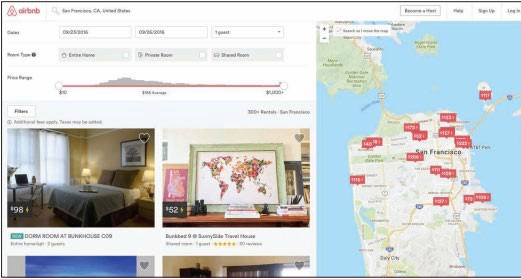
Airbnb, Inc. Fair Use
The roots of e-commerce lie in the 1970s and 1980s, when businesses extended their computer-based information systems beyond their corporate walls to connect with other companies’ systems, using electronic data interchange (EDI). EDI utilized private network services called value-added networks, or VANs, provided by telecom companies to transfer financial transactions safely and securely. Automating transactions using EDI drastically reduced the amount of paperwork and the need for human intervention.
The Internet provided the ideal platform for conducting EDI transactions as well as other forms of transaction processing between businesses. The web provided the first opportunity for businesses to conduct transactions with consumers over a computer network. Businesses and consumers alike embraced doing business online.
Today, there are three primary forms of e-commerce: B2C, B2B, and C2C. Web companies like Amazon.com represent a form of e-commerce called B2C. Business-to-consumer, or B2C, e-commerce uses the web or mobile apps to connect individual consumers directly with commercial sellers to purchase products. B2C ecommerce is sometimes called etail, a takeoff on the term “retail,” as it is the online equivalent of a brick-and-mortar retail store.
Although B2C is the most visible form of e-commerce, consumers’ online purchasing power pales in comparison to the amount of merchandise and services that businesses purchase online. Business-to-business, or B2B, e-commerce supports transactions between businesses across private networks, the Internet, and the web. Because businesses conduct frequent and high-volume transactions, B2B e-commerce is especially valuable. Although e-commerce makes up only 6.4 percent of all retail purchases, it makes up 27.7 percent of wholesale purchases and 60.9 percent of manufacturing purchases. Clearly, businesses have caught on to the financial benefits of conducting business online.
The third form of e-commerce is epitomized by the popular trend of consumers selling their own belongings on sites such as eBay and Craigslist. Consumer-to-consumer, or C2C, also called peer-to-peer, e-commerce uses the web to connect individuals who wish to sell to other individuals. Although eBay supports all forms of e-commerce, many credits it with being the first C2C e-commerce website. Craigslist, the online classifieds website, is a popular C2C site with more than 50 million people selling and buying items each month.
Read on to learn a lot more about how buyers and sellers take advantage of the benefits that e-commerce offers over all three types: B2C, B2B, and C2C.
Reading: Business-to-Consumer E-commerce
Business-to-Consumer (B2C) e-commerce uses the web or mobile apps to connect individual consumers directly with commercial sellers to purchase products.
Why This Matters
B2B e-commerce, sometimes referred to as eTail, has dramatically influenced the way people shop by providing customers with product information and the ability to comparison shop online. As eTail evolves, we may soon be able to click a button and have a product delivered to our doorsteps moments later by aerial drone.
Essential Information
There are several approaches to retail. A business can set up its own electronic storefronts, such as www.landsend.com or www.target.com, and provide visitors access to an electronic catalog of products (that far exceeds what could be displayed in a store), an electronic shopping cart for items they wish to purchase, and an electronic checkout procedure. Another eTail option is to lease space in a cybermall. A cybermall is a website that allows visitors to browse through a wide variety of products from varying retailers. Cybermalls are typically aligned with popular websites such as Yahoo!, Google, and MSN.
E-commerce strategies are continuously evolving to offer customers more options, convenience, and savings. Consider Amazon, which began as a simple online bookseller. It then began selling other products online, much like Walmart sells products in stores. It then expanded to allow retail partners to sell merchandise through Amazon, vastly increasing its inventory and taking a percentage of all sales. Now, anyone can sell new or used items through the Amazon website, which provides shoppers with a choice of vendors for many items and with the ability to purchase used merchandise.
Amazon further extended its domain to include local services. Amazon Home Services connects homeowners with local professionals in-home services, including painters, plumbers, electricians, cleaners, and landscapers. Amazon vets service providers to ensure high quality.
Amazon Prime provides additional benefits to shoppers. For a $99 annual fee ($49 for students), members enjoy special discounts, free movies, books, and music, and free two-day shipping on most items—a model that Google has adopted for its eTail service as well.
Google, Amazon, and other eTailers are experimenting with new technologies to reduce barriers to purchases. Amazon Dash provides shoppers with programmable buttons that can be placed around the house to automatically order an item when pressed. For example, you might stick the kitty litter button on the wall next to the litter box, where you can conveniently click it when you run out of kitty litter. Amazon’s Echo device for the home features an intelligent personal assistant named Alexa that allows residents to conveniently place orders for merchandise using voice commands: “Alexa, buy more kitty litter!”
Both Google and Amazon offer same-day delivery for specific products and locations and are experimenting with drone delivery systems. The systems would be invaluable for delivering products to remote areas, but ultimately, the companies hope to provide this new mode of delivery for everyone. However, drone systems have encountered pushback from the Federal Aviation Administration.
Increasingly, especially in regard to digital media, eTail is being integrated with branded devices and services. Amazon sells more ebooks than paperbacks due to the ease with which ebooks are sold and downloaded to tablets, smartphones, and other devices. Apple became the largest distributor of digital music due to the large number of people using its iTunes software on their various devices.
Apple, Microsoft, Google, and Amazon are all fighting to become your primary source for purchasing or renting all kinds of media—music, books, magazines, newspapers, games, apps, movies, and television shows. These media and services are sometimes tied to devices. For example, Google’s online media store, named Play, is designed to supply media to Android mobile devices. Apple iTunes is best used on iPhones and iPads. Microsoft’s Xbox Music delivers tunes to Windows-based devices. Of the big four, Amazon is the only company that delivers digital media to all kinds of devices with equal convenience. Consumers must choose which digital “ecosystem” they wish to buy into.
Reading: Consumer-to-Consumer E-commerce
Consumer-to-Consumer (C2C) e-commerce provides a platform for individuals to sell their belongings, products, and services to other individuals.
Why This Matters
Through the convenience and empowerment of e-commerce and the application of human ingenuity, the benefits of being able to sell products and services online have extended beyond traditional businesses to individuals. Today it’s easier than ever to make money by selling your unused stuff, or to start your own home-grown business.

Courtesy of eBay. Fair Use
Essential Information
Not too long ago, there were significant barriers that hampered the ability of people to sell online. A commercial bank account was needed to process credit card transactions. A special web hosting service was required to provide a commercial website, inventory navigation, shopping cart, and checkout services. There were legal considerations, liability concerns, and taxes to be paid, not to mention
complicated shipping logistics. But, as e-commerce has grown, platforms have emerged to remove many of these barriers and empower individuals to profit from e-commerce.

Kickstarter. Fair Use
Ebay was one of the earliest such platforms to emerge. Ebay was originally designed as an online auction for individuals to sell their unwanted belongings. Over time it evolved to support all types of transactions between all kinds of people and organizations. The key to eBay’s success was its sister company PayPal, one of the earliest online payment systems, allowing regular individuals to conduct transactions by transferring funds between credit cards and bank accounts. Ebay also introduced online shoppers to the use of a reputation management system that helped build trust in sellers and buyers.
Craigslist followed eBay in establishing C2C as a significant force in e-commerce. Craigslist is a network of online communities that provides free online classified advertisements. It is a popular online marketplace for purchasing items from local individuals. Today, shoppers turn to Craigslist rather than going to the classifieds in the local paper.
Upon observing the success of eBay and Craigslist, Amazon began supporting sales from non-business entities. Many others have followed suit: Etsy, ArtFire, and Zibbet for selling handmade crafts, Lulu for self-publishing books, Soundcloud for selling music. The vast majority of C2C platforms make money by charging membership fees, taking a percentage of money from sales, or both.
Another genre of C2C, known as crowdfunding, allows entrepreneurs to solicit for investment in products. Websites like Kickstarter and Indiegogo provide investors with early access to promising products in exchange for a financial investment. Other crowdfunding applications raise money for philanthropic purposes. For example, Kiva accepts donations in small amounts (microcredit) to support new businesses in developing countries. Gofundme.com provides crowdfunding for anyone with an idea or need that can raise money. Crowdfunding platforms exist for every type of project and need, from major corporate investments to wacky inventions to costly medical procedures. Along with the benefits provided by crowdfunding, there are significant risks. Sometimes, items promised are never delivered. For this reason, reputation plays a big role in the successful use of these platforms.

Uber Technologies. Fair Use
C2C has also impacted service industries. Perhaps Uber is the most easily recognizable example. Uber connects passengers with drivers willing to give them a ride through its easy-to-use mobile app. Founded in 2009, Uber has grown to include over 200,000 drivers around the world. Like many C2C platforms, Uber has disrupted an established industry—in this case the taxi industry.
Reading: Business-to-Business E-commerce
Business-to-Business (B2B) e-commerce supports transactions between businesses across private networks, the Internet, and the web.
Why This Matters
E-commerce was born out of the necessity for businesses to conduct transactions online. The earliest forms of e-commerce utilized private EDI networks to submit orders and transfer funds between businesses and banks. Over time, the online exchanges moved to the Internet, becoming more robust and supporting many business operations. Today, e-commerce is integrated into the daily operations of most businesses.
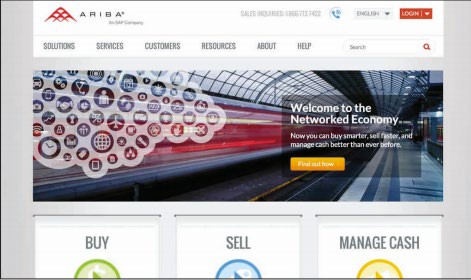
Courtesy of Ariba. Fair Use
Essential Information
Many B2B transactions are supported by the same mechanisms used in B2C. For example, a business might purchase large supplies of copy machine paper from the business solutions website provided by Office Depot. All that is required is an account that verifies your business, and you are given bulk rate pricing. You can peruse the catalog, add items to your shopping cart, and pay from your business credit account just as you would from the regular Office Depot site. In addition to standard e-commerce sites, special platforms have been developed specifically to support business needs.
A global supply management (GSM) service provides methods for businesses to find the best deals on the global market for raw materials and supplies needed to manufacture their products. There are many GSM products and services that promise to lower a business’s costs by providing connections to a wide variety of reputable suppliers, along with negotiation tools that enable a business to be assured that it is getting the best deal.
Ariba, a GSM company, advertises that its services and software can cut total supply costs by 45%. Alibaba is another GSM company that has been instrumental in building international relationships between businesses and in the global marketplace in general. GSM companies use a number of descriptive titles that include collaborative business commerce solutions and spend management services, but the gist is always the same—these services are intended to find the best deal for buyers in B2B transactions.
An electronic exchange is an industry-specific web resource created to provide a convenient, centralized platform for B2B e-commerce among manufacturers, suppliers, and customers. Some businesses join together with others in their industry to pool resources in web-based electronic exchanges. Electronic exchanges promote cooperation among competing companies for greater industry-wide efficiency and effectiveness. Through an electronic exchange, a manufacturer has access to a wide variety of industry-specific suppliers and services. Once business relationships are established among members, the electronic exchange provides the framework for fast and efficient transactions.
Covisint is an electronic exchange for a number of industries, including automotive manufacturers and healthcare. Founded by DaimlerChrysler AG, Ford Motor Company, General Motors, Nissan, and Renault, Covisint has created alliances among automotive manufacturers and suppliers and contracted several of the largest technology providers to create what Covisint claims is “the most successful business-to-business electronic exchange the world has ever seen.” Covisint members have access to online catalogs and auctions, tools that assist in quality management and problem-solving, and the industry portal shown in the figure.
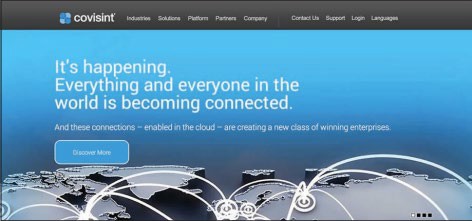
Courtesy of Compuware Corporation. Fair Use
Reading: E-commerce Tools, Techniques, and Technologies
E-commerce requires special tools, techniques, and technologies to address all of the stages of the buying and selling process in a manner that takes advantage of the latest innovations in computing.
Why This Matters
Buying and selling online requires new tools that are not required in the traditional shopping process. These include tools that get products into public awareness, safeguard transactions, deliver products, and support financial transactions. In order to shop online efficiently and safely, one must understand these tools, techniques, and technologies.
Essential Information
E-commerce companies must constantly consider how new breakthroughs in technology can be applied to support the buying and selling process. The level of speed and convenience provided by an e-commerce system can provide a company with a competitive advantage over its rivals. For example, the airline industry embraced QR codes and scanners to allow boarding passes to be scanned from passengers’ smartphones. Airlines that were able to provide this technology first were able to win over some customers from competitors.
The areas in which tools, techniques, and technologies are applied to empower online buying and selling include the quality of a company’s website and/or mobile app, the manner in which products are marketed, the level of customer trust a company has earned, the ease with which payments are accepted, and the speed with which products are delivered. These are the areas targeted in this section.
Reading: E-commerce Host
An e-commerce host is a company that takes on some or all of the responsibility of setting up and maintaining an e-commerce website and system for a business.
Why This Matters
Setting up and maintaining the infrastructure necessary for e-commerce is a big job. Most companies choose to outsource these tasks to professional e-commerce hosting companies. Hosting companies manage large servers that provide all the necessary software tools to deliver e-commerce applications, including an online catalog, a shopping cart, and transaction processing. E-commerce hosting sites maintain backups of online data and guarantee an extremely high percentage of uptime—time that the system is functioning without problems—typically above 95%. Many hosting companies also offer online marketing strategies to help e-commerce sites succeed. Put simply, e-commerce hosting sites are often better equipped to deliver a quality online presence than the businesses they serve.

Shopify. Fair Use
Essential Information
Hosting services range in price from under ten dollars a month to thousands of dollars per month, depending on the size of the business and the services offered by the host. Companies such as Shopify provide everything needed for a simple e-commerce online business—online catalog, shopping cart, and transaction processing—beginning at about $29.95 per month. For more money, you can get more storage space, accommodations for larger inventory (stock-keeping units or SKUs), lower transaction fees, and additional services. See the table below for some of the options for typical e-commerce hosting services.
Sample Web Hosting Packages
|
Feature |
Basic |
Pro |
Business |
Unlimited |
|
Monthly fee |
$29 |
$50 |
$99 |
$179 |
|
Bandwidth |
Unlimited |
|
|
|
|
Storage |
1 GB |
5 GB |
10 GB |
Unlimited |
|
SKUs |
100 |
2500 |
10,000 |
Unlimited |
|
Transaction fee |
2% |
1% |
1% |
0% |
Very large companies with more complicated systems might contract IBM or Sprint to work with their business to develop web e-commerce solutions at a considerably higher cost. For example, Office Depot contracted IBM to design and implement a complex web-based system that would accommodate transactions with customers and businesses.
Because many people shop online from mobile devices, many of today’s e-commerce hosting companies also provide mobile app development services. Companies can select to have an e-commerce website that is responsive and easily navigable on desktop or mobile devices or an app that can be installed on iPhones, iPads, or Android devices. An installed app offers the benefit of existing as an icon on the mobile device desktop. Installed apps may also provide additional features. The Amazon app, for example, allows you to scan a bar code with your phone camera to quickly find items in its inventory. The Walmart app allows you to quickly find the aisle where a product is located in your local store.
Reading: Online Marketing
Online marketing employs many strategies to make consumers aware of goods and services available for purchase online.
Why This Matters
As people migrated to the web as their primary source of news, information, and entertainment, businesses were forced to move their advertising dollars online to garner attention. While advertising online is essential for businesses to stay afloat, it is also essential for many websites and services that offer their content for free but still need to make money. There are many methods for marketing online, including search engine optimization, online business partnerships, ad-sponsored websites, games and apps, ads on search engines, via social media and by email, and location-based ads.
Essential Information
The Internet and the web provide opportunities for businesses to catch the eye of many more users than through traditional advertising media. Businesses provide informative websites for their products and services, making it much easier for customers to discover products that suit their needs. The trick for businesses is getting users to find and view their advertisements and websites.
Search engine optimization is a set of techniques that businesses use to get search engines to place their links higher in the list of search results. The ultimate goal is to be the first link returned from a user’s search on any related search term. However, competition is such that most businesses are happy just to appear on the first page of search results. To accomplish this, businesses create their web pages in a manner that allows search engines to easily identify the content and intent of the page. Then, they work to get other reputable businesses and individuals to link to their sites from their own pages in order to build a good online reputation. Search engines often use a popularity index to determine which sites are most useful and reputable, and they will place those sites high in search results.
Many free web services are financed with advertisements. Facebook, Google, Yahoo!, and other large Internet companies charge significant amounts to place ads on their sites. Some ads may be annoying and impossible to miss, as, in the case of some banner ads, pop-up ads, and ads that block the page until either you close them or a certain amount of time passes. Other ads may be subtle—targeted and designed not to intrude on the user experience—such as ads placed in the margins on Google and Facebook. Not only have ads become common on websites, but they have also begun to pop up in unexpected places like games and mobile apps. Which types of ads are most effective depends on the product and the customer.

Courtesy of NewsFactor. Fair Use
Companies continue to test the limits of what their viewers will tolerate when it comes to ads. Facebook has moved from ads in the sidebar to ads embedded in the newsfeed to silent videos in the newsfeed and is now experimenting to see if its members will tolerate video ads with audio enabled in their timelines.
Many people have installed browser plugins called ad blockers to block online ads. Companies like Facebook have used techniques to get ads past the blockers, but shortly thereafter, updates come out to counter those actions, leading to what is referred to as ad wars.
You’ll probably agree that what friends say about products is much more useful than what a company says about its own products. Social media plays a large part in online advertising as companies work to get customers to spread the word about their products. Businesses can create pages on Facebook or Google+ that users can “follow” or “like.” Businesses are smart to observe what others are saying about them on social media sites. Reputation management is the practice of tracking what users are saying about a company, online and elsewhere, and working to minimize negative comments and propagate positive ones.
Businesses can also reach out to the public through email and other messaging services. If a customer has a good relationship with a particular company, then advertising items of interest may be well received. Unfortunately for the advertisers, many of their advertisements are considered spam and are either automatically filtered out by the email service or immediately trashed.

Facebook. Fair Use
Location-based advertising uses location technologies like the GPS and compass in smartphones to provide mobile users with shopping information and coupons for businesses near their current location. When users “check-in” to a location on apps like Foursquare, they may be presented with a coupon for a discount. On slow days, a business may opt to run ad-hoc specials to lure passersby. Based on a customer’s profile, the deal can be customized to meet what the customer is likely to be willing to spend.
Today’s marketing practices integrate all forms of advertising into one cohesive package. Integrated marketing combines television and radio advertising, print advertising, and web advertising—especially on social media—taking advantage of the unique features of each type of media to promote and spread a common message and brand image. Many businesses are calling on professional marketing companies to assist with extending their brand presence to social media.
Reading: Online Reputation
Online reputation has become an important consideration when choosing businesses, people, products, and services to work with or purchase online.
Why This Matters
Online sellers must build their reputation in order to win over customers. Online buyers need to be cautious about whom they do business with to avoid the many hustlers and frauds who make a living taking advantage of the gullible and vulnerable. Understanding online reputation helps everyone conduct business in a safe manner.
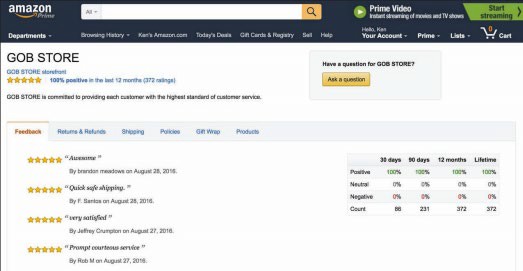
Amazon. Fair Use
Essential Information
It’s hard to know who to trust online. Technologies such as digital certificates help to identify a business as legitimate and transactions as safe, but do not ensure that you are dealing with a reputable business.
As mentioned earlier, eBay was one of the first online ecommerce platforms that offered a rating system for buyers and sellers. Such systems have become standard for online retailers and marketplaces like Amazon and Google. Not only are such rating systems useful in gaining trust in a business, but they also serve to show customer satisfaction with products and services. Although such systems can be “gamed” by some users to provide false information for the good of the company, when the feedback gets up into the hundreds or thousands of buyers, the rating is likely to indicate the quality of the product or company.
Most large businesses invest in reputation management services. In fact, a whole industry has grown up around this service. A reputation management company provides services that include analyzing the online reputation of a company and advising changes to result in improved online image, scouring the web for negative comments or image-tarnishing content and working to have the content taken down, and promoting the company in a manner that results in positive feedback.
As you consider the online reputation of businesses, consider your own online reputation. It is common practice for employers to search the web to learn what they can about the reputation of job candidates. It’s never too soon to work on your own reputation management.
Reading: Electronic Payment Systems
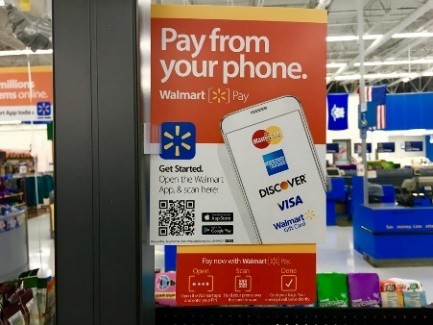 “Walmart Pay, 9/2016, Pay from your phone!, pics by Mike Mozart of TheToyChannel and JeepersMedia on YouTube #Walmart #Pay #Phone” by JeepersMedia is licensed under CC BY 2.0
“Walmart Pay, 9/2016, Pay from your phone!, pics by Mike Mozart of TheToyChannel and JeepersMedia on YouTube #Walmart #Pay #Phone” by JeepersMedia is licensed under CC BY 2.0
Tech companies, banks, and credit card companies are all heavily invested in developing electronic payment systems based on new technologies designed to do away with cash, credit cards, and wallets.
Why This Matters
Electronic payment systems facilitate online payments in situations where buyers or sellers are unable to participate in a standard cash or credit card transaction. Apple, Google, Samsung, and others are all hoping that you’ll buy into their payment systems so that they can support all of your financial transactions.
Essential Information
In most e-commerce transactions, the customer typically pays with a credit card number (B2C) or a merchant account number (B2B). Using a secure encrypted connection, the buyer enters the account information into a web form and submits it. The merchant’s web server passes the information along to the payment processing system, which checks the validity of the account number and the balance in the account. If the credit card checks out, the transaction is processed. The only difference between online credit card processing and in-store processing is that laws require online retailers to wait until shipping the product to deduct funds from the credit card. Because of this, eTailers put a hold on the funds until the product is shipped, at which time the funds are transferred.
Electronic payment systems, sometimes called digital wallet services, provide a private and secure method of transferring funds from a bank account or credit card to online vendors or individuals. Early systems, provided by companies like PayPal, were designed to manage transactions on the web. The more recent generation of payment systems is designed for mobile payments.
Apple Pay, Google’s Android Pay, Samsung Pay, and similar technologies utilize smartphones with near-field communication technology, such as RFID, to allow shoppers to swipe their phones at checkout to pay for items. With these payment systems, shoppers can pay for products by clicking a button in a mobile app. The idea is to store a user’s financial data, such as credit card information, online with one service. That service can then be used to conduct transactions that take place both online and in stores using an app. Even Amazon and Facebook are getting into eCash, allowing customers to pay for items using their Amazon or Facebook login.
Payment systems are extending to wearable devices. Apple Watch owners can pay at checkout by swiping their watch over the scanner. Google’s Hands-Free app bypasses the need to get your phone out. At checkout, just say, “I’ll pay with Google,” and the cashier will confirm your identity using face recognition technology and send you on your way.
Some aren’t satisfied with streamlining transactions; they want to improve the currency itself. Bitcoin is a digital currency introduced in 2008 to replace the common currencies of the world. Bitcoin transactions take place online, with vendors that accept the currency, are verified by network nodes, and recorded in a distributed ledger called a blockchain. Because Bitcoin requires no central authority, it is considered a decentralized digital currency.
Bitcoin is accepted by over 100,000 merchants worldwide. It is the standard currency of hackers on the darknet where stolen and illegal goods are bought and sold. Bitcoin is ideal for illegal transactions because it cannot be easily traced. The value of a Bitcoin varies widely.
Reading: Shipping

“IMG_0050” by techmsg is licensed under CC BY 2.0
Shipping has become a major concern for e-commerce companies seeking to maximize efficiency and effectiveness in product delivery.
Why This Matters
Amazon and Google are able to fulfill orders in two days for most products and locations, and the same day for particular items in limited locations. Both companies want to do better and are utilizing new technologies and strategies to shave time off of deliveries. Some day in the not too distant future, you will be able to click a button on the screen of your phone, anywhere in the world, and have the product handed to you in under an hour.
Essential Information
The race to see which company can deliver goods to your doorstep fastest is on! In December 2013, Amazon captured the attention and imagination of the world when it announced that it was planning to deliver goods via unmanned aerial vehicles, better known as drones. In 2014, Google revealed that its researchers had been testing drone delivery for two years in a project named Project Wing. Since then companies around the world have been making the news with pilot programs delivering everything from medical supplies to pizzas via drone aircraft. Although the implementation of drone delivery has been slowed by safety concerns from the U.S. Federal Aviation Administration and similar agencies abroad, it’s clear that this method of delivery will eventually be utilized.
Drones aren’t the only method for shaving hours or days off delivery times. Amazon has invested in a fleet of 737s to assist in taking control of its delivery systems. Rather than relying on FedEx, Amazon figures it can streamline the movement of merchandise around the country and world by owning its own airplanes. The company has also bought a fleet of trailer trucks.
Some companies are looking to crowdsource delivery. That is, they hire people heading in the right direction to deliver a package along the way for a small payment. Amazon has been experimenting with this idea in a program named “On My Way.”
These efforts make it clear that the winners in e-commerce will be companies that are most successful at streamlining all of the components of the buying and selling process. Today, much of the focus is on delivery.
Lesson 14.2: E-commerce Tools
Lesson 14.2 Introduction
Business systems are computer-based information systems that provide organizations with valuable information in a timely and effective manner to allow the functional areas of the enterprise to work together to achieve goals.
Decisions lie at the heart of just about everything people do. It is impossible to get through a day without making many decisions—some large, some small. In our careers, some decisions can have great significance and affect many other people. Business systems are designed to collect, store, and disseminate information needed to make good business decisions in all types of jobs and all types of professions.
Satellite television giant DIRECTV adopted business system software from a company named SAS to analyze its customer billing data. DIRECTV has complex billing systems that are used by nearly 20,000 customer service agents offering dozens or hundreds of different promotions, offers, discounts, and modified pricing plans at any given time. Put it all together and the potential for errors in billing and payments is high and could be very costly. SAS business systems software scoured all transaction data in DIRECTV’s database and identified $10 million in revenue leakage.
DIRECTV isn’t alone. T-Mobile analyzes huge amounts of data that it collects on its customers in order to identify which customers are likely to switch to a different carrier and then make them offers to keep them happy. The Orlando Magic uses data analytics to provide fans with merchandise they like at prices they are willing to pay, making the team one of the top revenue earners in the NBA despite being the 20th largest market.
The world’s financial health is dependent on an information economy. Businesses generate profits based on how well they collect, interpret, and act on information. Not only do businesses depend on the flow of information, but governments, nonprofit organizations, research institutes, and others also benefit greatly from information management and analysis. As you read this unit, consider what information is useful for professionals in areas that interest you. How have the leaders in those industries profited from collecting and interpreting information?
There are many different business systems designed for various types of businesses, various functional areas within business, and different activities within business processes. For example, a transaction processing system, or TPS, is a business information system used to support the process of making a purchase; a management information system, or MIS, provides all types of factual information to managers to assist them with decisions; and an enterprise resource planning, or ERP, system is designed to connect all of the information systems within a business into one cohesive system.
This section covers the most common types of business systems used in today’s businesses and organizations and discusses how those information systems are developed. Whether you intend to work in a large organization, be part of a small to medium-sized business (SMB), or run your own business, knowledge of business systems is essential to your success.
Information systems are able to “connect the dots” from many data sources to provide insight into otherwise neglected facts. While this process is often unobtrusive—such as tracking market trends—it can, at times, intrude into individuals’ private lives. Businesses and governments are able to piece together information from many sources to build a detailed profile of an individual. Since the most significant actions that people take are recorded digitally through business transactions, government records, phone records, and online activity, today’s information economy is slowly but surely eroding privacy. Although businesses may be able to offer customers a higher level of service by targeting their interests, some individuals feel that their privacy is being violated in the process.
When information systems “go bad,” they have the potential for causing major problems. Bugs in information systems, as well as human error and threats to information security, can result in identity theft, fraud, financial loss, and serious damage to a business. Some worry that society has become overly dependent on information systems and will ultimately pay the price.
Reading: Information Management
Information management refers to software and computer-based systems dedicated to collecting, storing, and manipulating data in a manner that produces useful information on which to base decisions.
Why This Matters
If there is one lesson in business that has proven to be important, it is that information is power. In business, government, or any goal-oriented endeavor, the more accurate the information you have to work with, the more efficiently and effectively you will reach your goals. The challenge is to discover which data is important and which is insignificant. This is the era of “big data,” where our online dealings and transactions are generating enormous amounts of data each day. Our ability to collect and analyze that data to produce actionable information has become increasingly difficult but remains one of the most valuable business activities.
Essential Information
There are thousands of different types of systems designed to manage information—millions if you count the custom-designed systems that are used in many businesses. However, most can be classified under one of four general headings: transaction processing systems, management information systems, business intelligence systems, and expert systems.
These four types of systems build one upon the other and become more complex and intelligent to serve various purposes, as shown in the opening figure on this page. A transaction processing system (TPS) serves as a foundation for the other systems. It collects information about transactions, including the sale of merchandise and services, the salaries paid to employees, and purchases of raw materials. A management information system (MIS) draws information from the database of transactions and other sources to inform managers of the state of operations such as inventory amounts, sales statistics, and product performance. A business intelligence (BI) system draws on information from an MIS, a TPS, and other sources to provide problem-specific information to assist decision-makers. An expert system applies artificial intelligence techniques, drawing from information provided from other systems to aid higher-level decision making.
Since expert systems fall under the heading of artificial intelligence, they are covered in the AI section of Emerge with Computers. Other types of information management systems that are having a global impact include geographic information systems and medical and biological informatics.
Reading: Transaction Processing System
A transaction processing system (TPS) is an information system used to support and record transactions such as paying for products or paying an employee.
Why This Matters
Transaction processing takes place in many different environments, and the systems that support them are created to suit the environment. The electronic checkout system at Amazon.com is a TPS, as is the checkout system at your local bookstore or grocery store. The payroll system that calculates an employee’s pay and cuts a check is also a TPS. The ATM at your bank is a TPS, as is the keypad on a gas station pump. Newer forms of TPS include mobile payment systems that allow you to tap your smartphone against a pad at check out. The TPS is the foundation of today’s economies.
Essential Information
A transaction is a commercial exchange involving goods, services, and/or money, such as buying medical supplies for a hospital or purchasing and downloading music on the Internet. A transaction processing system (TPS) is an information system used to support and record transactions, such as paying for products or paying an employee. The transaction information collected by the TPS is fundamental to the operation of other information systems that support important decision-making. For example, the company contracted to provide food services for a college campus uses a TPS to collect sales information from the cashier’s point-of-sale terminal in the school cafeteria. That sales information is then
processed by another information system, such as a management information system (MIS), to determine which food items are selling best. Items that aren’t selling may be either discounted or discontinued and replaced with new items. Through this approach, the food service provider can use the transaction information to continuously improve both its service to customers and its profit margin.
Businesses and banks can collect massive amounts of consumer information from transaction data. To gain access to that information, businesses, banks, and tech companies are all competing to process your transactions. Apple would like you to use Apple Pay for your purchases; Google would like you to use Google Wallet; Samsung wants you to use Samsung Pay, and banks would like everyone to use credit card-based systems. As more and more consumers embrace mobile payment systems, the competition in this area is heating up.
All forms of transaction processing systems share a common set of activities called the transaction processing cycle. The stages of the transaction processing cycle include the following:
- Data collection: Capture transaction-related data such as item number, quantity, and payment method
- Data editing: Check the validity of the data entered, such as whether the item number and credit card number are valid
- Data correction: Request correction if data editing reveals invalid data
- Data manipulation: Process the transaction data and calculate totals, tax, shipping, etc.
- Data storage: Store transaction-related data in the transaction database
- Data output: Output receipts, picking lists for the warehouse, or other documents
In each step of transaction processing and in each subsystem, businesses strive to carry out the action in a streamlined manner with the least amount of effort and cost and the highest amount of speed and quality. In this way, transaction processing systems can assist a business in gaining an edge over the competition.
Reading: Management Information System
A management information system (MIS) provides routine business information to decision makers in a useful and convenient format.
Why This Matters
The primary purpose of an MIS is to help individuals, businesses, and organizations achieve their goals by providing reports and information to make better decisions. Individuals, for example, might want to get reports from their doctor on the results of a routine physical exam. A business manager uses MIS reports to maintain inventory levels so that there are no shortages or surpluses. By filtering and analyzing highly detailed data, an MIS can provide information to help people and businesses make important decisions.
Essential Information
An MIS is fueled by databases. It pulls data from one or more databases, sorts and sifts the data based on specific criteria, and produces reports of useful information. The primary source of input for a business MIS is its transaction database. Transaction processing systems record data in a database for every transaction within a business—credits and debits. An MIS can mine transaction data for interesting trends and important statistics. For example, a hotel chain may find that occupancy at its hotels that provide free wireless Internet access is 8 percent higher than in locations where there is a fee for Internet access.
Using this information, management may determine that the money made from Internet access is not as much as would be gained by an 8 percent increase in occupancy, and begin offering free Wi-Fi at all hotel locations. An MIS may also access data from other internal databases, such as inventory and personnel, and external databases, such as stock market prices or weather reports.
The output of most management information systems is a collection of reports. These reports can be produced on paper or electronically. The primary types of reports are:
- Scheduled report: Produced periodically or on a schedule, such as daily, weekly, or monthly.
- Key-indicator report: A special type of scheduled report that summarizes the previous day’s critical activities and is typically available at the beginning of each workday.
- Demand report: Developed to retrieve certain information at a person’s request—in other words, these reports are produced on demand.
- Exception report: Automatically produced when a situation is unusual or requires action.
The following table lists the types of reports associated with the various functional units of a business, illustrating how MISs are integrated with all areas of an organization’s operations.
Types of MIS Reports
|
Business area |
Reports |
|
Financial |
Payables Receivables General Ledger Profitability |
|
Human Resources (HR) |
Compensation HR Performance Retention Workforce Profile and Compliance |
|
Order Management and Fulfillment |
Business Performance Billing Order Fulfillment |
|
Supply Chain |
Procurement and Spending Supplier Performance Inventory |
|
Sales |
Profits by Product Profits by Customer Competition Analysis |
|
Service |
Service Effectiveness Employee Effectiveness Customer Insight |
|
Contact Center |
Customer Service Agent Performance Service and Delivery Cost Contact Center Sales |
|
Marketing |
Marketing Planning Campaign Performance Customer Insight |
Reading: Decision Making

“What’s Your Next Move?” by Maurits Verbiest is licensed under CC BY 2.0
Decision-making is the key component of the problem-solving process and takes place in three stages: intelligence, design, and choice.
Why This Matters
One of the highest compliments is to be recognized by your friends and coworkers as a real problem solver. In general, problem-solving is the most critical activity an individual or organization undertakes. It makes the difference between success and failure, as well as between profit and loss. Computer-based information systems are extremely valuable to individuals, businesses, and organizations in their support of making the best decisions. To understand how information systems support the decision-making process, it helps to understand the process itself.
Essential Information
Individuals, businesses, and organizations must make decisions to solve problems and take advantage of opportunities. The process of problem-solving begins with decision-making, which takes place in three stages: intelligence, design, and choice. Problem-solving includes and goes beyond decision-making to implement a solution and monitor the situation.
- Intelligence stage: In the intelligence-gathering stage, problems and opportunities are identified and defined. Information is gathered that relates to the cause and scope of the problem or opportunity. The problem or opportunity environment is investigated, and things that might constrain the solution are identified.
- Design stage: During this stage, alternative solutions to the problem are developed. In addition, the feasibility and implications of these alternatives are evaluated.
- Choice stage: This stage involves selecting a course of action.
- Implementation stage: In this stage, action is taken to put the solution into effect.
- Monitoring stage: In this stage, the decision makers evaluate the implementation of the solution to determine whether the anticipated results were achieved and to modify the process in light of new information learned during the implementation stage. The monitoring stage involves a feedback and adjustment process.
Businesses prefer to be proactive in their problem-solving approach, seeking out potential problems before they become serious. The alternative, being reactive, puts a business at a disadvantage, as it always struggles to move forward.
Programmed decisions are easy ones that are made based on experience, using a rule, procedure, or quantitative method. Nonprogrammed decisions, however, deal with unusual or exceptional situations. In many cases, these decisions are difficult to represent as a rule, procedure, or quantitative method.
Programmed decisions are easy to automate with a computer system, while nonprogrammed decisions often require human intelligence.
Mind mapping software serves as a powerful tool to assist in decision-making. A mind map is a graphic representation of the variables and components of a problem or solution and the relationships between them. Using a mind map, decision-makers can map their way to an organized solution with careful consideration of all the details.
Reading: Business Intelligence Analytics
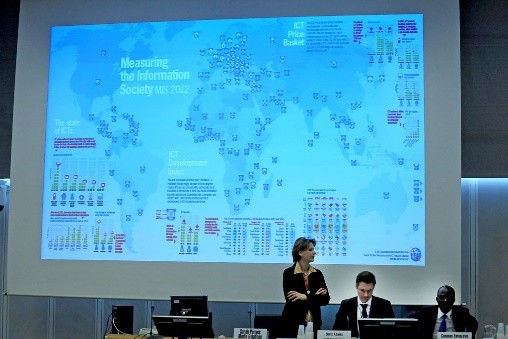 “Measuring the Information Society 2012” by ITU Pictures is licensed under CC BY 2.0
“Measuring the Information Society 2012” by ITU Pictures is licensed under CC BY 2.0
Business intelligence (BI) and analytics refer to technologies that are used to gather and report information that supports intelligent business decision-making.
Why This Matters
BI is a contemporary term for an MIS designed for specific business needs. BI has become a buzzword in business because of its ability to propel a company forward. In this era of Big Data, data analytics has presented corporations with their greatest challenges and opportunities. Good business intelligence makes for smarter decision-making, giving a company a strong competitive advantage.
Essential Information
Business intelligence (BI) systems analyze the information produced by MISs and provide more precise insight into business operations and opportunities. BI often focuses on key performance indicators (KPIs) to analyze a business’s health. KPIs are statistics that provide insight into the state of a business, such as sales figures and social media activity. BI is a powerful tool for providing a business with a competitive advantage. Because of this, many technology companies are selling tools centered on business intelligence. Oracle has a division called Oracle Business Intelligence, Microsoft has SQL Server Business Intelligence, and IBM has Data Warehousing and Business Intelligence. BI differs from MIS in that it not only provides reports but also provides the ability to forecast the future based on past events. Analytics is the part of BI that performs extensive analysis of data. It may include statistical and quantitative analysis, explanatory and predictive modeling, and other analytical processes. In this manner, BI can act as an informed advisor to business decision-makers.
Some BI systems display key-indicator data together on one page in a format called an executive dashboard. Executive dashboards can display graphs and charts and allow the users to drill down into the data to view more detailed reports. Management information systems providers such as Cognos, SAS, IBM, and Oracle provide real-time reporting through a dashboard-style display that allows decision-makers to stay connected to dynamic changes in the business.
Reading: Geographic Information System

“Tours J” is licensed under CC BY 2.0
A geographic information system (GIS) captures, manages, analyzes, and displays geographically referenced information, often utilizing maps with overlaid data.
Why This Matters
Geographic information systems allow researchers in many professions to relate abstract data to physical locations in order to understand the interplay between conditions on the ground and situations or phenomena represented by the data. GISs are useful to everyone, but they are particularly useful to professionals who work with populations or geographic phenomena and data, such as urban planners, social workers, law enforcement personnel, sociologists, geologists, meteorologists, civil engineers, and those who work in government agencies.
Essential Information
A map is the quintessential GIS, relaying geographical information—city locations, roads, distances between cities, elevations, and other information—on a graphical representation of the earth. GISs typically overlay maps with data and information related to geographic locations. The Virtual Earth applications from Microsoft and Google are popular GISs. Using satellite imagery as a foundation, Google Earth and Microsoft Bing Maps overlay different types of geographic information, such as roads, traffic density, items of interest, weather, and different types of businesses. With the advent of GPS in mobile phones, GIS has gone mobile, providing travelers and pedestrians with directions and information on nearby businesses, attractions, and even friends.
While GIS systems are used by the general public every day, their real power lies in how they are leveraged in research and industry to make discoveries and inform decisions. A 911 operator uses a GIS to quickly determine the specific location of a caller with an emergency. Businesses use GISs to display sales information for a specific region of the country. Wendy’s uses ArcGIS software to determine the best location for new restaurants. The military uses GISs along with GPSs (global positioning systems) to target enemy forces. GISs are used to observe scientific phenomena, assess the environmental impact of social action, assist in urban planning, assist law enforcement in identifying high-crime areas, create effective marketing strategies, and do many other professional activities. In any situation where a geographic location plays a role, GIS software provides strong support.
GIS software is an important tool for professionals in geography, meteorology, urban planning, criminology, and social sciences. Learning to use GIS software, such as Autodesk and packages developed by Esri, consumes large quantities of time for students studying in these areas.
Reading: Informatics

“Environment Wide Association Study” by Kohane is licensed under CC BY 2.0
Informatics applies computer-based information system technologies to support traditional disciplines such as science and medicine.
Why This Matters
Traditionally, computer-based information systems have had a business focus—to provide information to decision-makers to help their companies gain a competitive advantage. Today, professionals in many nonbusiness disciplines are utilizing computer systems to manage different types of information. Although informatics is a term that can be applied to all types of information systems, it is primarily used to describe the use of information systems in nonbusiness areas. Informatics is particularly popular in the sciences, where it is revolutionizing research in biology and helping to organize medical recordkeeping.
Essential Information
Bioinformatics and medical informatics are two areas where informatics has had a large impact.
Bioinformatics combines biology and computer science. Also called computational biology, bioinformatics has been used to map the human genome and conduct research on biological organisms.
Medical informatics applies information systems to traditional medical research. Medical informatics seeks to reduce medical errors and improve healthcare delivery by using computer systems and technology.
The U.S. Centers for Disease Control and Prevention and the Office of the National Coordinator for Health IT have put in place several initiatives to standardize electronic health records (EHR) across the U.S. in efforts to improve public health.
Other areas of informatics include astroinformatics, organizational informatics, biodiversity informatics, cheminformatics, ecoinformatics, geoinformatics, neuroinformatics, and social informatics.
Many schools offer a degree in informatics, one that typically combines studies in a particular discipline (i.e. psychology) with studies in computing and information technologies in order to apply the technology to the particular discipline.
Reading: Enterprise Systems
Enterprise systems are information systems designed to support the functions of an enterprise, including knowledge management, content management, and customer relationship management as well as the integration of these functions into enterprise resource planning systems.
Why This Matters
Whether a business has only a few employees or is a global corporation with thousands of employees, it is important that everyone in the business has access to a common pool of information, preferably through a common user interface. Enterprise systems are designed to provide that common information framework. Enterprise is another word for business, but often it connotes a large, complex business with many interacting business units. Although enterprises are often very large global businesses, the information management practices of a large enterprise can also benefit small and medium-sized businesses. Enterprise systems are useful to businesses of every size.
Essential Information
In the several decades that computer-based information systems have been around, the role that they play in business has changed from supporting business processes to being an integral part of the process that businesses depend on to create and add value to their products and services. Today, information systems often control business processes, and good information systems provide a framework for best practices in business management. Information system developers pride themselves on understanding key elements of business practices that are most valued in an enterprise, and they design systems that provide innovative processes to give a business a competitive edge.
Information systems such as knowledge management, content management, and customer relationship management can make or break a business. These systems are considered enterprise systems because they are fundamental to an enterprise. An enterprise resource planning system is the ultimate information system in an organization because it integrates all enterprise systems into one centralized system. A structured systems development process is often used by businesses to create and maintain information systems.
Reading: Knowledge Management
A knowledge management (KM) system assists an organization in capturing, storing, and distributing knowledge for use and reuse by the organization and, sometimes, its partners and customers.
Why This Matters
Knowledge is much more valuable to the world when it is shared. Unfortunately, much of what people learn remains untapped because they don’t have the opportunity to share it. In a business environment, this can be costly. Training new employees is time-consuming and expensive. The longer an employee stays with a company, the more valuable the employee becomes because of the acquisition of corporate knowledge. If and when an employee leaves the company, it is a costly loss for the enterprise unless the knowledge the departing person has acquired can somehow remain in the enterprise. Knowledge management systems allow people to share and disperse their knowledge to help propel the group forward.
Essential Information
In the mid-1990s, it was recognized that organizational knowledge existed primarily in the minds of employees and that there was a need to record and dispense this knowledge in a way that benefited the organization. Thus, knowledge management systems were born. When individuals in an organization share their insight, it allows others with less experience or skill to learn and become more valuable to the organization. Also, the ability to share knowledge with partners and customers fosters good communication and relationships. Although there are nontechnical approaches to knowledge management, technology has become key to collecting and distributing knowledge and providing communication channels between knowledge holders and knowledge seekers. The term knowledge worker originated in the field of knowledge management.
Knowledge management systems are diverse. All information systems assist in managing knowledge to some extent. Some are more directly focused on dispersing knowledge. Many businesses use knowledge management systems that include social networking features to allow members of the organization to post their knowledge and experiences more easily.
Some businesses and organizations provide a knowledge base that can be queried to find solutions to product- or service-related issues. Citrix Systems, Inc., a networking software company, set up an online knowledge base for its customers that reduced calls to its call centers by 30 percent within the first month.
Other companies are experimenting with wikis that act as knowledge bases for corporate information. A collaborative framework like a wiki provides an ideal tool for collecting and sharing knowledge in an organization. A number of software companies, like Traction Software and Atlassian, have built businesses around developing enterprise wiki software for corporate knowledge management.
A knowledge base often includes all of the above, merging social media, blogs, and wikis with traditional MIS systems that provide reports and charts with critical information. These services are usually provided through one central desktop portal that employees can access throughout the workday.
Reading: Customer Relationship Management
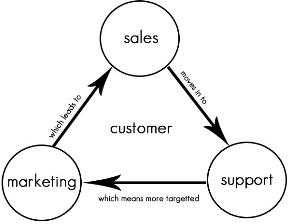
“CRM” by Sean MacEntee is licensed under CC BY 2.0
Customer relationship management (CRM) refers to the use of information systems to store detailed information on prospective, current, and past customers to improve customer service and support targeted marketing.
Why This Matters
With competition in all businesses and industries at its peak, businesses and enterprises are turning to high levels of customer service to win customer loyalty. Customer relationship management (CRM) systems allow a business to track all interactions with customers, including in-store, by phone, and online, to better understand a customer’s interests and needs so that they may be fulfilled.
Essential Information
Customers appreciate personalized attention. That’s the key to CRM. CRM ensures that employees within an organization are equipped with the information necessary to treat a customer like an old friend, even if they’ve never met the customer before.
A good CRM system records all customer interactions with a business. Information on one particular customer can be accessed and entered by personnel from across an organization. Information can also be gathered automatically, such as when a customer interacts with the company’s online website. For example, when Bob Butterworth phones Sunshine Electronics’ customer support, the operator can quickly pull up Bob’s record to see that Bob phoned two weeks ago and ordered a new HDTV and deduce that this call is probably in reference to the TV. Also, Bob has spent a considerable amount of time on the Sunshine Electronics website looking at surround sound systems; perhaps the operator could interest Bob in a special deal on a new sound system.
Businesses that implement CRM systems have found significant increases in the level of customer satisfaction and retention, along with reduced operating costs. CRM systems support many areas of an enterprise, including market research, sales, marketing, customer support, and product development. CRM system developers are quick to point out that CRM software by itself will not improve customer satisfaction. CRM should be approached holistically with a heavy emphasis on training personnel on how to interact with customers.
Reading: Enterprise Resource Planning

“Nissen & Velten-Entwickler an Bildschirmen” by Nissen&Velten is licensed under CC BY 2.0 An
enterprise resource planning (ERP) system integrates all data processing in a corporation (enterprise) into one unified system that draws from a central database system to streamline the flow of information throughout an enterprise and provide greater efficiencies and savings.
Why This Matters
As information systems and technologies advanced over recent years, many businesses haphazardly adopted the latest and greatest technologies and eventually found themselves with overly complex systems that were expensive, difficult to maintain, and complicated to use. Many businesses found themselves dependent on several information systems designed for various business units by different vendors with a variety of compatibility issues. Enterprise resource planning is used to overhaul an information infrastructure to create one integrated system that streamlines the flow of information throughout the enterprise, allowing decision-makers to implement cost-saving efficiencies.
Essential Information
An ERP system for a large business includes components for manufacturing, supply chain management, financials, projects, human resources, customer relationship management, and data warehousing. All of these systems share data, have a standardized user interface, and are centrally administered and maintained.
Supply chain management refers to the control of a product’s development process through the supply chain, which includes acquiring raw materials for manufacturing, the manufacturing process itself, shipping, storage in warehouses, delivery to vendors, vendor inventory, sales, and after-sales support. ERP is valuable in part for its role in streamlining communication and information across the supply chain. For example, an ERP could inform a customer service representative of how long it will take for a replacement part to be shipped based on on-hand inventory amounts and a supplier’s backlog. But, ERP does much more than just manage the supply chain; it can include many other useful information systems.
Over the past decade, many corporations have implemented ERP systems with dramatic results. As you might imagine, adopting an ERP system is a major undertaking. Every information system in the organization is studied and redesigned. Old systems are gradually retired while the new systems are activated. For a large business, the process takes years and millions of dollars. Typically, a corporation contracts with a professional ERP vendor to manage the design and installation of the system. Popular vendors include Oracle, Microsoft, IBM/Cognos, SAS, and SAP BusinessObjects. When the transition to an ERP system is complete, employees find that they can accomplish much more in less time.
Cloud computing has had a tremendous impact on the implementation of ERP systems. New vendors of “cloud ERP” have arisen to challenge traditional ERP systems that are installed on corporate systems. Cloud ERP systems are stored on vendor web servers and can be accessed from any Internet-connected device. Some enterprises are mixing and matching systems, complementing their local ERP system with additional cloud solutions.
Benefits and Drawbacks of ERP Systems
|
Benefits |
Drawbacks |
|
|
Reading: Systems Development
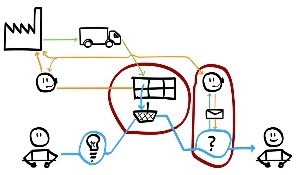
“07c Mapping Customer Journey” by Espen Klem is licensed under CC BY 2.0
Systems development is the activity of creating new information systems or modifying existing ones.
Why This Matters
Information systems are developed to solve the problems of individuals, businesses, and organizations. Everyone who interacts with software and information systems should be involved with the process of systems development so that new systems effectively and efficiently meet everyone’s needs. Once the domain of systems analysts and computer programmers, systems development is now taking place at all levels of business, in a variety of environments, involving all types of professionals.
Essential Information
Systems development efforts can range from a small project, such as purchasing inexpensive computer software, to a major undertaking, such as installing a huge system that includes hardware, software, telecommunications systems, and databases, and which requires new computer systems personnel.
Some systems development projects can involve an investment of millions of dollars but are designed to create a quick return on investment (ROI). For example, in a multimillion-dollar systems development project, Verizon Wireless integrated 13 billing systems into one to support 62 million customers and 30,000 call center agents across the country, reducing operating costs by 15 to 20 percent and saving Verizon $20 million a year.
Organizations have used different approaches to developing information systems. In some cases, these approaches are formalized and captured in volumes of documents. In other cases, less formal approaches are used. The steps of systems development vary from one organization to the next, but most approaches have six common phases: investigation, analysis, design, implementation, maintenance, and review. Combined, these stages are referred to as the systems development life cycle (SDLC).
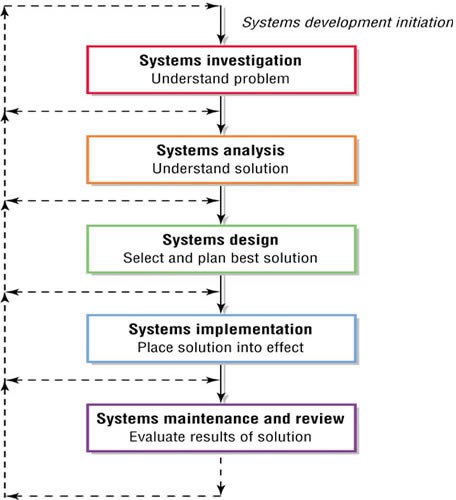
Authored by Cengage Learning. Creative Commons Attribution 4.0 International (CC BY 4.0)
The systems development process is an ongoing and cyclic activity. Once a system is developed, it is reviewed and revised as needed over the life of the system. Systems investigation and analysis look at the existing system and determine if it can and should be improved. Systems design and implementation involve modifying an existing system or developing a new one and placing it into operation. Finally, maintenance and review make sure that the new or modified system is operating as intended.
At the conclusion of each stage of the SDLC, a report may be generated to review the progress of the project. It may be decided that the project must return to a previous stage to be reworked or perhaps even scrapped. If all is going well, the project is given the green light to continue on to the next stage of development.
Many people take part in the systems development process. A systems analyst is a professional who specializes in analyzing and designing systems. A systems analyst interacts with system stakeholders, business managers, software engineers, system users, and vendors to design a system that best supports the goals of the organization.
Project management tools and techniques are often used to keep systems development projects on track. For example, a Gantt chart (shown below) may be used to track multiple project activities over time.

Courtesy of Microsoft Corporation. Fair Use
Lesson 14.3: Globalization
Lesson 14.3 Introduction

“Worldwide” is licensed under CC0 1.0
Globalization refers to changes in societies and the world economy resulting from dramatically increased international trade and cultural exchange.
The Internet and other forms of global telecommunications have supported a rapid increase in global business and business relationships. With the increase in global communications and cooperation among international businesses, our cultures and economies are becoming interdependent. Such an environment provides advantages for businesses in both developing and developed countries. It also provides new challenges and dangers.
In 2010, Google made history when it broke off relations with China and closed its offices in Beijing. Many, including some Google stockholders, called the move insane. China is well recognized as the world’s largest growing economy. While every other business was bending over backward to do business in China, Google was pulling out. Why? Because Google was no longer willing to censor search results in accordance with Chinese law. Google gave China an ultimatum—allow us to serve uncensored search results or we shut down—and without blinking, the Chinese government chose the latter in the years since Google reopened google.cn and provided visitors with warnings when searching for censored keywords. For a time, Google even provided Chinese citizens with instructions on how to circumvent the great firewall of China and avoid Chinese police.
Google in China is just one of many instances where globalization has failed. Apple has suffered severe criticism for being the most successful business in the world while ignoring dangerous or fatal conditions at its factories in China. Although Apple may have little control over conditions at the factories where its products are assembled, it is held up as an example of Western abuse of poor workers in developing countries.
As globalization creates business partners around the world, there are bound to be cultural clashes and serious disagreements over how business should be conducted. What types of challenges do you imagine confronting a business as it begins to expand abroad? How would you advise global corporations to contend with cultural differences? What would you recommend Apple do to correct its image problem?
The largest contributors to globalization are computers, a global telecommunications infrastructure, and the Internet. High-speed fiber-optic networks make it possible to communicate with, befriend, and collaborate with individuals around the globe as if they were sitting across the table from you. These technologies, which break the traditional barriers of time and space, have created a global community and economy.
Today, many companies use a distributed workforce, where portions of product design and production take place through a collaboration of several companies, each providing a specialized service.
Companies are chosen for collaboration based on quality, reputation, and price. Location is often not a consideration due to the conveniences provided by the Internet and telecommunications technologies. These global partnerships aim to produce the highest-quality product at the lowest possible cost. The distributed global business model has created intense competition, especially for businesses that compete with businesses in developing countries where labor costs are much lower.
Reading: Distributed Workforce

“iGoogle Hangout” by jamjar is licensed under CC BY 2.0
A distributed workforce combines the talents of individuals from different businesses and locations to work together on a common product or project.
Why This Matters
Competition in the marketplace is fierce, and technology is the primary tool for gaining an edge. Businesses are continuously redesigning themselves to take advantage of the latest technological advances. Digital technology supports an increasingly distributed workforce, where portions of product development may be accomplished in different parts of the world. The goal is always to produce the most attractive product at the lowest possible cost. The distributed workforce requires professionals to adapt to a new work environment and routine. Knowledge workers must be fluent in communication technologies and able to collaborate well with others from diverse cultural backgrounds.
Essential Information
The Internet makes it increasingly easy to communicate and collaborate with individuals from around the world. The Internet boom of the 1990s supported the growth of telecommunications infrastructure, including the installation of many undersea cables connecting most parts of the world. These connections supported high-speed data communications and brought Internet services to many parts of the world for the first time. This set the stage for new partnerships between businesses in developed and developing nations, providing opportunities for those living in developing countries and cost savings for businesses in developed countries. Innovative software was developed to support collaboration among workers in different locations, facilitating the growth of distributed work environments.
Today, many businesses outsource portions of their work processes to take advantage of talent outside their own organization and to save money. It is not unusual for a product to be designed through a collaborative effort among several designers in different cities, to have its parts manufactured at a location overseas (offshoring), to be assembled by another company in another part of the world, to be tested by yet another company, and to be shipped and stored by yet others. The whole project is managed by the company that puts its logo on the finished product.
Participating in a distributed workforce takes unique talents. Communication and technology skills are valued. Meetings are often held online, with files shared among team members. Project management skills are particularly useful, as keeping track of the progress and budgets of multiple units is essential to ensure that no time or money is wasted.
Some companies are finding that managing work processes around the world has some drawbacks. GM, Apple, and others have been bringing manufacturing plants back to the U.S., where they can more easily communicate with other branches of the company. In particular, companies find benefits in having engineers and designers work side-by-side with manufacturing to produce better products.
Still, from all indicators, it appears that the globalization and distribution of work processes are a major part of the global economy. It is highly likely that today’s students will be interacting with individuals and businesses from around the world in their professional endeavors. It might be useful to consider acquiring skills that are unique and valuable and may not likely be offered at a lower price by others in a global market.
Reading: Outsourcing
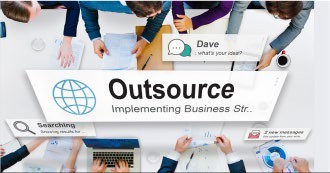
“Outsource Task Contract Work Supplier Concept” is licensed under CC0 1.0
Outsourcing refers to a business’ use of an outside company to take over portions of its workload.
Why This Matters
Many businesses are finding that they can save significant amounts of time, effort, and money by hiring outside businesses to perform specialized tasks. A business might decide to hire IBM to create and manage its corporate information systems. Doing so might provide the business with a higher quality system and a lot fewer headaches. Another business might hire a plant in China to manufacture a component for its product and a plant in Taiwan to assemble the product. Doing so might save the company millions due to the low cost of manufacturing in these countries compared to that of the United States or the United Kingdom. Outsourcing provides benefits to some (those saving money, time, and effort and those getting the work) and hardships for others (those unable to compete with the low wages of developing countries).
Essential Information
Have you ever heard of the Y2K bug? The Y2K bug was the problem faced at the end of the twentieth century due to computer systems using only two-digit codes to represent years. When the year switched from 1999 to 2000 (Y2K), most computer systems progressed from 99 to 00, going back one hundred years instead of forward one year. Consequently, many people anticipated that at the stroke of midnight on December 31, 1999, electronic systems would fail in every industry, including vital areas such as banking, medical equipment, manufacturing, and transportation.
Because there were not enough computer programmers available to prepare for Y2K, and recognizing the opportunities provided by new undersea telecom cables that joined the U.S. to India, many companies outsourced their Y2K problems to India. When the new year arrived without any significant problems, many thought that the entire Y2K scare was all hype. It is more probable that the programmers in India were responsible for saving the day.
Indian programmers earned the respect of many large U.S. corporations, as well as corporations in other developed nations, through their participation in Y2K efforts and other projects. Because Indian programmers worked for pennies on the dollar compared to workers in the United States and other developed nations, it wasn’t long before most major companies called upon Indian programmers for many routine programming jobs. Communication lines between the United States and India became busy with IT business as teams in the two countries collaborated. Software to manage distributed project components became an urgent need, and software companies responded with sophisticated workflow packages. Workflow software empowered project managers to stay in touch with team members around the world and manage multiple project modules. Team members dispersed around the world could communicate in real-time through text, voice, or video and pass around project files as though they were sharing a conference table.
Bangalore (see image) has become known as the Silicon Valley of India. Technology companies, such as Microsoft, IBM, Texas Instruments, HP, and GE, set up shop in Bangalore, building large corporate offices there. Any service that can be digitized and handled by the Indian workforce is being outsourced. Call center operations, U.S. tax returns, medical imaging analysis, news reporting, publishing, you name it—India can do it more cheaply than developed countries. Although some of the work being outsourced consists of basic, low-skill services, one can assume that higher levels of work will be outsourced as Indian education levels rise. In fact, Microsoft has opened a significant research facility in Bangalore.
Although India is the biggest destination of outsourced services, Russia, the Philippines, Ireland, Israel, China, and other countries also provide outsourced services. China especially has become popular since its huge and rapidly developing population is becoming one of the world’s most valuable markets. Even the United States provides outsourced services. The difference between countries is in the type of services they can offer. The United States, with its advanced technology skills, exports services and products that are available nowhere else.
If you are starting to see the big picture of nations’ trading services and competing with each other in price and quality on a global scale, you are beginning to understand globalization. Enlarging the marketplace from local to global can have a profound impact on national and international economies. For example, outsourcing low-end tech jobs to India has provided a boom in India’s economy, while thousands of U.S. workers who once did the work now being outsourced have been laid off. The prosperity in India increases the demand for U.S. products in India, which in turn provides growth in some U.S. industries and creates the need to hire more labor. In the United States, there is a general shift in employment from low-skill labor to higher-skill labor and a demand for U.S. companies to be creative innovators in order to remain leaders in the global economy.
Recently, there has been a backlash against outsourcing in the U.S. Some companies have moved their call center operations back to the U.S. so their customers can communicate with individuals who are culturally the same. Other companies are moving manufacturing operations back to the U.S. to have more control over the process and closer communications between corporate units. The trend of repossessing previously outsourced operations is called insourcing. Outsourcing is reaching an equilibrium as corporations determine which operations are best to outsource and which are best to keep in-house.
Reading: Offshoring
Offshoring is a business practice that relocates an entire production line to another location, typically in another country, in order to enjoy cheaper labor, lower taxes, and other forms of lower overhead.
Why This Matters
Offshoring has had a major impact on manufacturing in both wealthy and developing countries. In the United States, offshoring has devastated some industries, such as the textile industry, which cannot compete with China and other countries on price. Offshoring has, for the most part, elevated the economies of developing countries that are winning the business of their wealthier global neighbors. In some industries, offshoring has created a complicated market. For example, U.S. automakers have offshored some of their production to China and elsewhere, while many Chinese auto companies have cars that are wholly manufactured in the United States. In difficult economic times, offshoring is a hotly debated practice.
Essential Information
Offshoring is somewhat different from outsourcing. With outsourcing, a portion of the work process is hired out. With offshoring, entire production lines are relocated to another country. If Bangalore, India is the current global center of outsourcing, then Beijing, China is the global center of offshoring. At the end of 2001, when China joined the World Trade Organization and agreed to follow international trade laws, it opened a floodgate for trade and innovation. Corporations around the world sought to take advantage of China’s large population, cheap labor, and high-quality production to save on manufacturing costs.
Textiles, furniture, consumer electronics, and a host of other products are manufactured in China for global distribution for a fraction of the cost of manufacturing in more developed countries.
Companies that take advantage of the cost savings by manufacturing in China and other low-cost manufacturing centers in the developing world (like Eastern Europe) gain a considerable advantage over competitors that don’t. Many business consultants recommend that U.S. companies offshore labor-intensive operations in order to stay competitive. Businesses in other developed nations are following suit. As with outsourcing, offshoring has created concerns for the labor markets in developed countries, especially in the United States. But, as with outsourcing, offshoring is predominantly used to save money on low-skill, labor-intensive manufacturing. Higher-level manufacturing still takes place in the United States. For example, General Motors may use some parts manufactured in China in vehicles assembled in Detroit.
As with India, a growing and prosperous China means increasing demand there for U.S. products. Many U.S. companies have opened branches in China in order to have the first crack at the huge market that is developing there. The United States remains the world’s largest manufacturer, leading the world in aerospace, pharmaceuticals, automobiles, and other high-tech industries. Through globalization, the field of competition has broadened significantly. As with outsourcing, offshoring is forcing U.S. businesses to stay innovative and competitive.
Reading: International Business Models

“McDonald’s in Marrakesh” by Richard Allaway is licensed under CC BY 2.0
International business models include methods of engaging in international business ranging from basic import/export to fully transnational businesses.
Why This Matters
Engaging in a global market is complicated, with many models and levels of engagement. Understanding how companies approach global business is useful for understanding the global economy and its options, as well as the challenges involved.
Essential Information
With the benefits of working in the global arena come substantial challenges:
- Culture: Countries and regions have their own cultures and customs that can have a significant impact on individuals and organizations involved in global trade.
- Language: Language differences are another challenge. In some cases, it is difficult to translate exact meanings from one language to another. An exact translation of an advertising slogan, for example, might have a totally different meaning or even be offensive or disgusting to people in other countries.
- Time and distance: Time and distance issues can be difficult to overcome for individuals and organizations involved with global trade in remote locations. In other cases, they can provide an advantage. For example, outsourcing to India enables a company to work 24 hours a day because it is the day in India when it is night in the United States.
- Infrastructure: People and organizations operating in developed countries expect an excellent infrastructure. In some countries, electricity may fluctuate in voltage, damaging machines, and computers, or maybe off for large periods of the day. Water might be dirty, and phone and Internet service might be problematic.
- Currency: The value of different currencies can vary significantly over time. Sometimes, currencies can dramatically fluctuate in a few days or less.
- State, regional, and national laws: Every state, region, and country has a set of laws that must be obeyed by individuals and organizations operating within the respective area. These laws can deal with a variety of issues, including trade secrets, patents, copyrights, protection of personal data, protection of financial data, and privacy.
Organizations participate in the global marketplace in several different ways, depending on where the organization’s operations are located and how they are managed, as shown in the following table.
Types of Organizations in the Global Economy
|
Company type |
Description |
|
International company |
An international company maintains management and operations in its home country, exporting or importing products to and from other countries. |
|
Multinational company |
A multinational company maintains management in its home country and is supported by operations distributed across several countries. These companies typically market products specifically to satisfy the needs of their customers in different countries. |
|
Global company |
A global company is similar to a multinational company except that it markets its brand and products in the same way across all countries, regardless of cultural differences. |
|
Transnational company |
A transnational company has complex management distributed across multiple countries and operations. Often, it is difficult to name a home country for a transnational business. |
